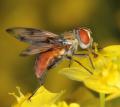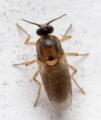Diptera.info :: Identification queries :: Diptera (adults)
Who is here? 1 guest(s)
|
Anthomyia sp.
|
|
| Rui Andrade |
Posted on 21-02-2008 21:07
|
|
Member Location: Portugal Posts: 3123 Joined: 19.06.07 |
I found this male anthomyiid in Oporto, Portugal on the 21st of February, 2008. I don't think this belongs to the species Anthomyia pluvialis because of what Tony Irwin said in this thread: http://www.dipter...post_27521 (on the third picture I put a red circle on what I think Tony is refering to). Another question: regarding the first two photos, what do these different stances mean? Is it protecting its territory?   
Edited by Rui Andrade on 25-02-2008 23:21 |
| Tony Irwin |
Posted on 21-02-2008 21:49
|
|
Member Location: Norwich, England Posts: 7306 Joined: 19.11.04 |
I agree that all we can say about this is that's it's Anthomyia species. An interesting question about stance - I'm not sure that Anthomyia hold territories - possibly they do in Portugal! I wonder whether the fly which is closer to the substrate is using heat in the rock to warm up, or whether it is concerned that the higher pose is making it too conspicuous to predators. A few weeks of close observation (Nikita-style  ) may provide some of the answers. ) may provide some of the answers.
Tony ---------- Tony Irwin |
|
|
|
| Rui Andrade |
Posted on 21-02-2008 22:09
|
|
Member Location: Portugal Posts: 3123 Joined: 19.06.07 |
Thanks Tony . .It is the same individual in both photos. When it became aware of my presence it would crouch. I mentioned the territory because I saw some of them brawling in the air. |
| Michael Ackland |
Posted on 23-02-2008 16:57
|
|
Member Location: Dorset UK Posts: 680 Joined: 23.02.08 |
Could be Anthomyia quinquemaculata Macq. which is found along mediterranean latitudes from Canary Isles to Middle East. I can see no anterodorsal seta on mid tibia, and the red outlined photo detail is like the named species. Also the membranouus lobe on sternite V seems to be projecting somewhat, though A. procellaris is similar. If you want a definite id you need to examine the male genitalia, as Anthomyia in Europpe are difficult. |
|
|
|
| jorgemotalmeida |
Posted on 24-02-2008 16:49
|
|
Member Location: Viseu - PORTUGAL Posts: 9296 Joined: 05.06.06 |
For those who don't know in quinquemaculata we have the words quinque that is in Latin the equivalent to number five (5). And maculata is plural in Latin meaning spots, I.E. (id est - or, in English, that is) scutum has 5 spots. [edit (this was wrong): As you can see clearly 3 on left side + 1 on scutellum, and the other not visible here.] In A. pluvialis that red circle would have a split in those maculata in two 
Edited by jorgemotalmeida on 24-02-2008 17:47 |
| Michael Ackland |
Posted on 24-02-2008 17:10
|
|
Member Location: Dorset UK Posts: 680 Joined: 23.02.08 |
The five spots are on the scutum, one in the centre (postsutural) and the two laterally; you don't count the one on the scutellum |
|
|
|
| jorgemotalmeida |
Posted on 24-02-2008 17:18
|
|
Member Location: Viseu - PORTUGAL Posts: 9296 Joined: 05.06.06 |
thanks for the correction.  Look, see 2nd page . It has a photo taken by myself with the title Head of anthomyiid. Can you take a look, please?  |
| Rui Andrade |
Posted on 25-02-2008 23:20
|
|
Member Location: Portugal Posts: 3123 Joined: 19.06.07 |
Thank you for your help, I'll leave it as Anthomyia sp. |
| Jump to Forum: |













